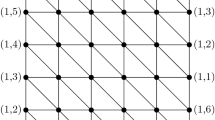Abstract
We describe an algorithm to subdivide an arbitrary triangulation of a surface to produce a triangulation that is vertex-colorable with three colors. (Three-colorable triangulations can be efficiently represented and manipulated by the GEM data structure of Montagner and Stolfi.) The standard solution to this problem is the barycentric subdivision, which produces 6n triangles when applied to a triangulation with n faces. Our algorithm yields a subdivision with at most 2n − m + 4(2 − χ) triangles, where χ is the Euler characteristic of the surface and m is the number of border edges (adjacent to only one triangle). This bound is rarely reached in practice; in particular, if the triangulation is already three-colorable the algorithm does not split any triangles.
Access this chapter
Tax calculation will be finalised at checkout
Purchases are for personal use only
Preview
Unable to display preview. Download preview PDF.
Similar content being viewed by others
References
Montagner, A., Stolfi, J.: Gems: A general data structure for d-dimensional triangulations. Technical Report IC-06-16, Computer Science Institute, UNICAMP (2006), http://www.ic.unicamp.br/~reltech/2006/06-16.pdf
Montagner, A.J.: A Estrutura de Dados Gema para Representação de Mapas n-Dimensionais. Masters Dissertation, Computer Science Institute, UNICAMP (2007) (in Portuguese), http://www.bibliotecadigital.unicamp.br/document/?code=vtls000431432
Lins, S., Mandel, A.: Graph-encoded 3-manifolds. Discrete Mathematics 57(3), 261–284 (1985)
Bing, R.H.: Geometric Topology of 3-Manifolds. Colloquium Publications vol. 40 (1983)
Bollobás, B.: Modern Graph Theory. Springer, New York (1998)
Alexandroff, P.S.: Combinatorial Topology. Dover, New York (1998)
Kruskal, J.B.: On the Shortest Spanning Subtree of a Graph and the Traveling Salesman Problem. Proc. American Mathematical Society 7, 48–50 (1956)
Tsai, M., West, D.B.: A new proof of 3-colorability of Eulerian triangulations. Mathematica Contemporanea 4(1) (2011)
Author information
Authors and Affiliations
Editor information
Editors and Affiliations
Rights and permissions
Copyright information
© 2013 Springer-Verlag Berlin Heidelberg
About this paper
Cite this paper
Bueno, L.M., Stolfi, J. (2013). Economic 3-Colored Subdivision of Triangulations. In: Bodlaender, H.L., Italiano, G.F. (eds) Algorithms – ESA 2013. ESA 2013. Lecture Notes in Computer Science, vol 8125. Springer, Berlin, Heidelberg. https://doi.org/10.1007/978-3-642-40450-4_23
Download citation
DOI: https://doi.org/10.1007/978-3-642-40450-4_23
Publisher Name: Springer, Berlin, Heidelberg
Print ISBN: 978-3-642-40449-8
Online ISBN: 978-3-642-40450-4
eBook Packages: Computer ScienceComputer Science (R0)




